It’s No Use
On Caspar Heinemann at Studio Voltaire
Twenty-four ‘decoy’ ducks are suspended from black ropes attached high in the vaulted ceiling of Studio Voltaire, a former Methodist church in Clapham, South London. The ducks of Dead Ducks have their backs to us. The dark black panelled wood becomes the murky waters of the pond – and the white walls of the gallery the sky. In Caspar Heinemann’s Sod All, is it we, the viewer, who are hung upside down by the work or do dead ducks fly above us? Neither option quite makes sense.
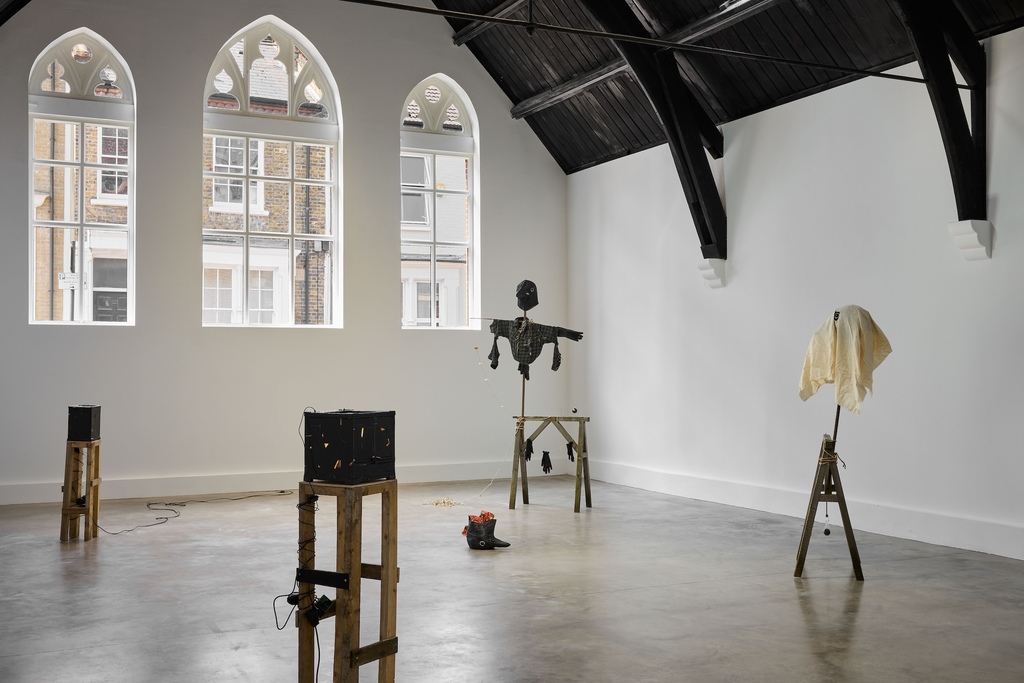
Caspar Heinemann, Sod All, 2025. Installation view at Studio Voltaire. Images courtesy
of the artist, Cabinet Gallery, and Studio Voltaire. Credit Sarah Rainer.
"It’s about making art less weighted by the functions that the things in our everyday lives hold"
I ask the artist how important it is that there are things about his work the audience can’t know. 'In a quite utopian way I think there’s something really beautiful in the fact it doesn’t matter. And that you can get there despite the not-knowing.' Heinemann wants to stress that in art how we receive things, think through them, and work toward something else is distinct. It’s about making art less weighted by the functions that the things in our everyday lives hold.
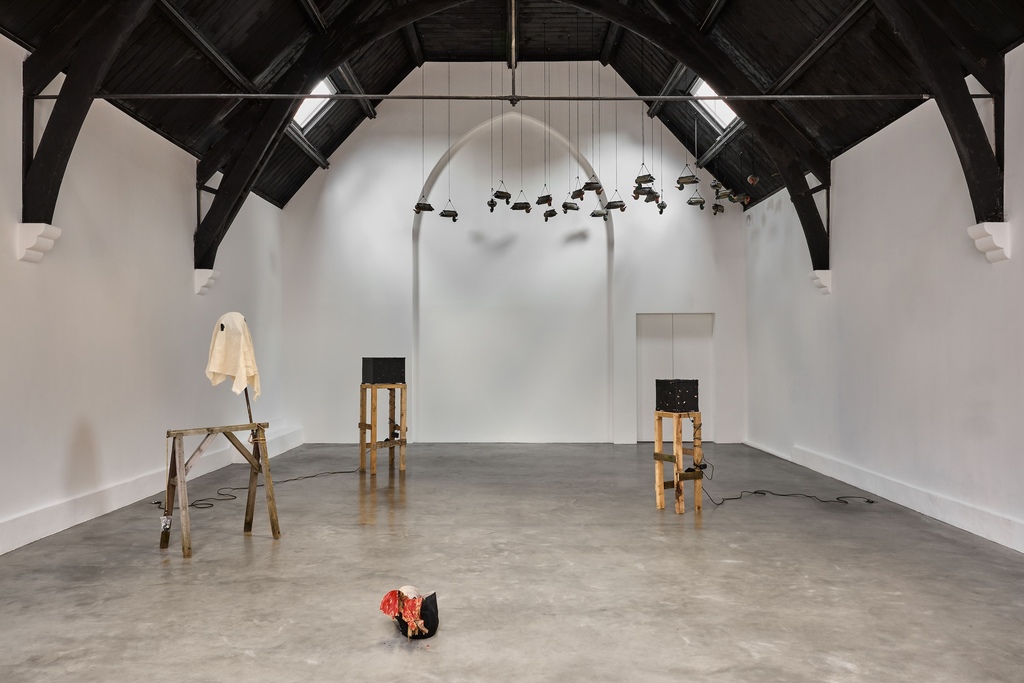
Caspar Heinemann, Sod All, 2025. Installation view at Studio Voltaire. Images courtesy
of the artist, Cabinet Gallery, and Studio Voltaire. Credit Sarah Rainer.
Why should art be useful? Sod All partly begs this question. Heinemann builds a series of sculptures from found materials, salvaged items, and strange objects he discovered online to create things that are unwieldy, silly, dark, and without use. The first institutional show by the artist and poet, across these new works the viewer experiences many such suspensions, obscurations, and switches of meaning – with everyday materials repurposed into sculptures that then become emptied of the function that the original materials contain. The viewer has to break the ways that they usually think about objects to find connections within it.
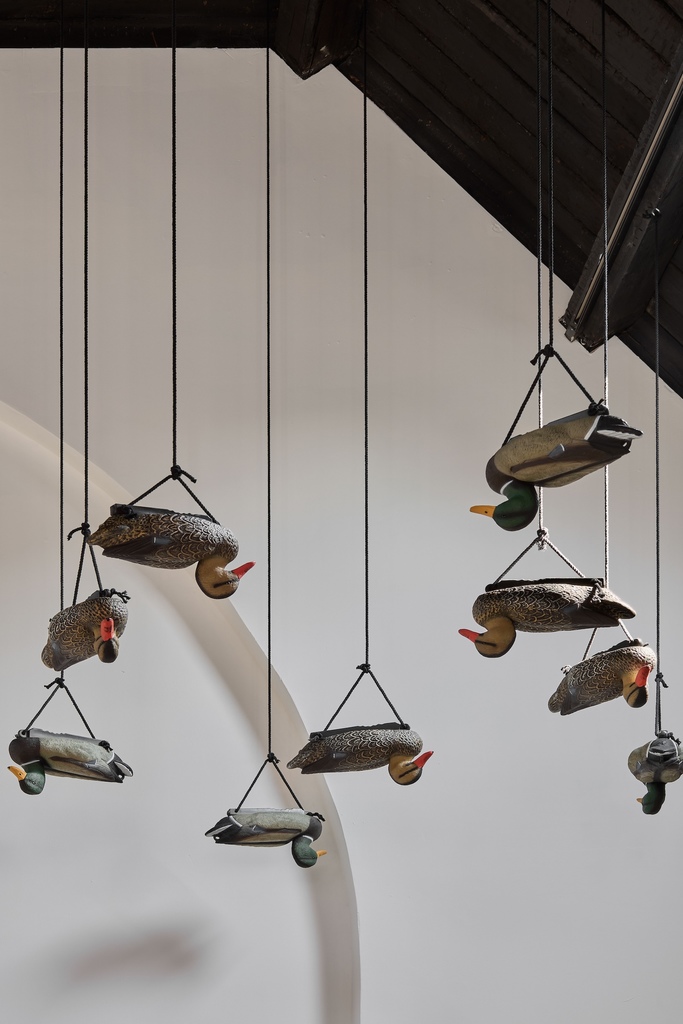
Caspar Heinemann, Sod All, 2025. Installation view at Studio Voltaire. Images courtesy
of the artist, Cabinet Gallery, and Studio Voltaire. Credit Sarah Rainer.
"Heinemann builds a series of sculptures from found materials, salvaged items, and strange objects he discovered online to create things that are unwieldy, silly, dark, and without use."
In one sequence of work, Scarer 1, Scarer 2, and Scarer 3, two rickety-wooden sawhorses stand adjacent. On Scarer 1 sits the rubber head of a crow stuffed into a green plaid shirt once worn by the artist, and decorated with dried straw. There’s something bloody in the bird’s mouth. On top of Scarer 2 sits a white sheet with two eye holes cut out, attached to something like a head on a broom handle. An 8ball dangles from a bungee cord – and on the floor lies the decapitated head of another crow, Scarer 3. Each of these ‘Scarers’ is an imitation of a device commonly used by farmers to keep birds from eating their crops. Reimagined, Heinemann undertakes a kind of creative trespass, an unruly homage to the inventions found in the hinterlands.
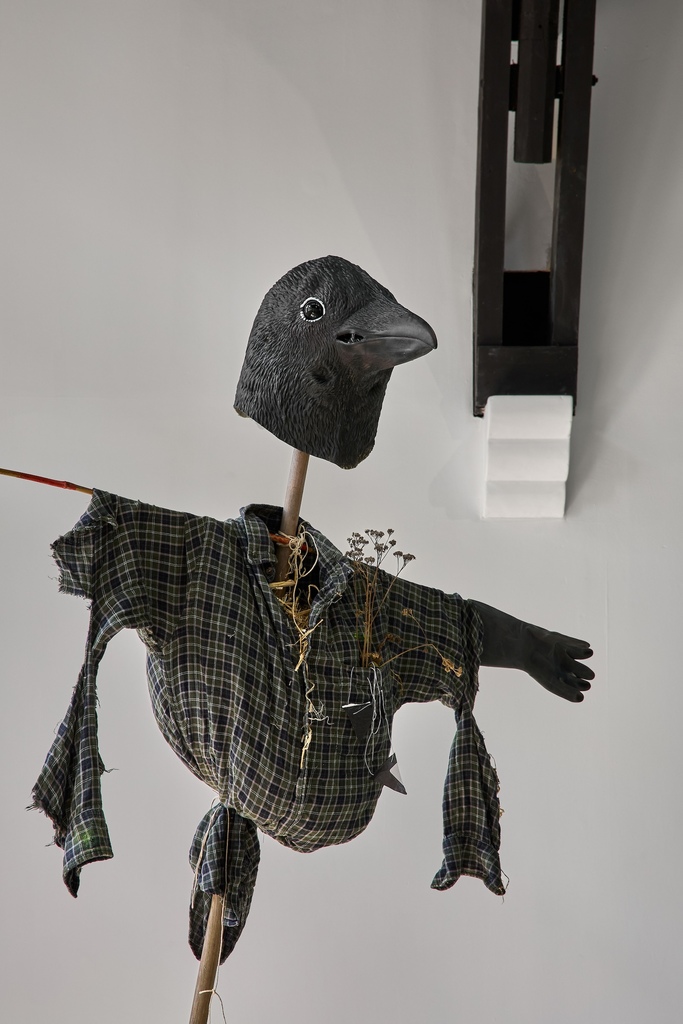
Caspar Heinemann, Sod All, 2025. Installation view at Studio Voltaire. Images courtesy
of the artist, Cabinet Gallery, and Studio Voltaire. Credit Sarah Rainer.
In another sequence, Time Machine A, Time Machine C, and Time Machine D, three reptile terrariums are each placed on rickety-wooden stools built by the artist in his Glasgow studio. What’s inside? The view into each box is hindered by layers of black duct tape placed around the tanks, with tiny gaps allowing for brief glimpses of miniatures of Roman and Grecian ruins placed on top of pet shop gravel, the glare of a heat lamp just about visible (reduced to a tiny purple flicker in Time Machine D, the smallest of the three boxes).
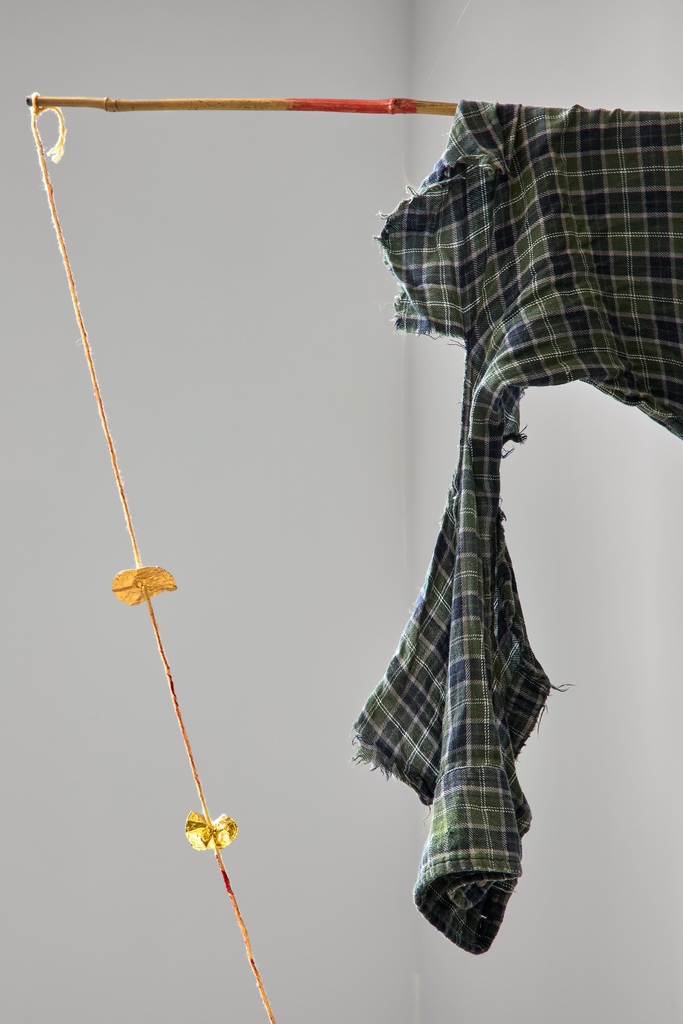
Caspar Heinemann, Sod All, 2025. Installation view at Studio Voltaire. Images courtesy
of the artist, Cabinet Gallery, and Studio Voltaire. Credit Sarah Rainer.
As we discuss the show Heinemann tells me how he is fascinated by these ornaments. The rubber ruins can symbolise the fascistic idealisation of lost civilisations. But, equally, for many people they’re just stupid things that their goldfish swim around. The artist makes them part of a comic set of sculptures about the contingency of symbols – how something violent gets locked away, obscured, even, or how it can also become something insignificant.
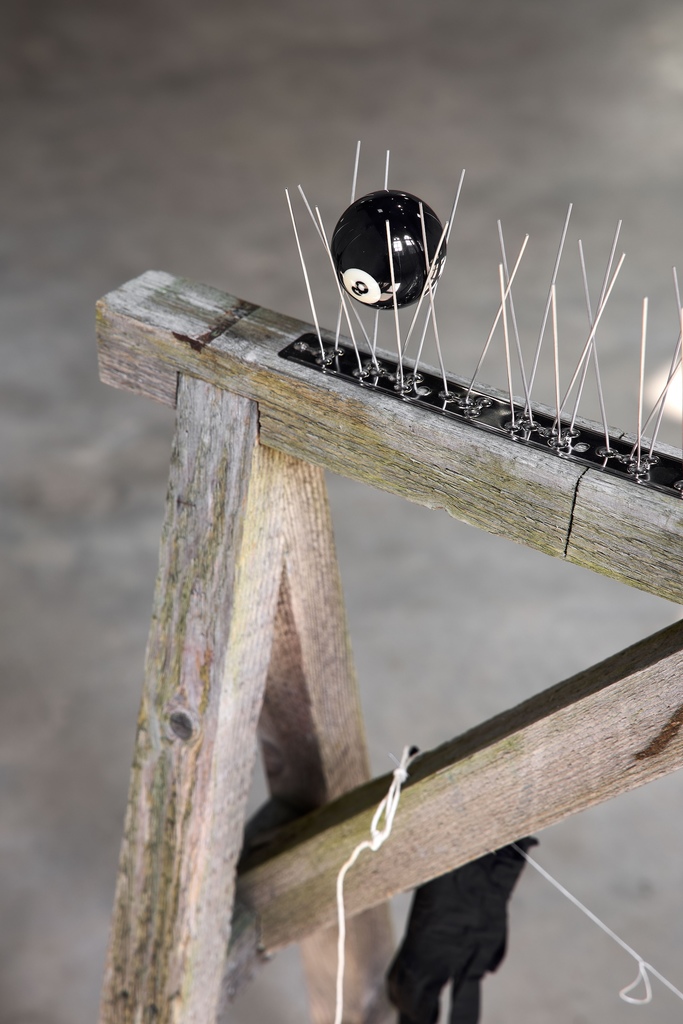
Caspar Heinemann, Sod All, 2025. Installation view at Studio Voltaire. Images courtesy
of the artist, Cabinet Gallery, and Studio Voltaire. Credit Sarah Rainer.
Whether it’s salvaged wood, disposable safety gloves, or rubber crow’s heads – across Sod All, the artist makes use of everyday objects to create clashes of register, inviting the viewer to make their own readings. Through combination, unity, and non-alignment Heinemann diminishes these objects from their practical or hobbyist uses. Instead, making meaning from things that are non-functional, not-working, something close to broken.
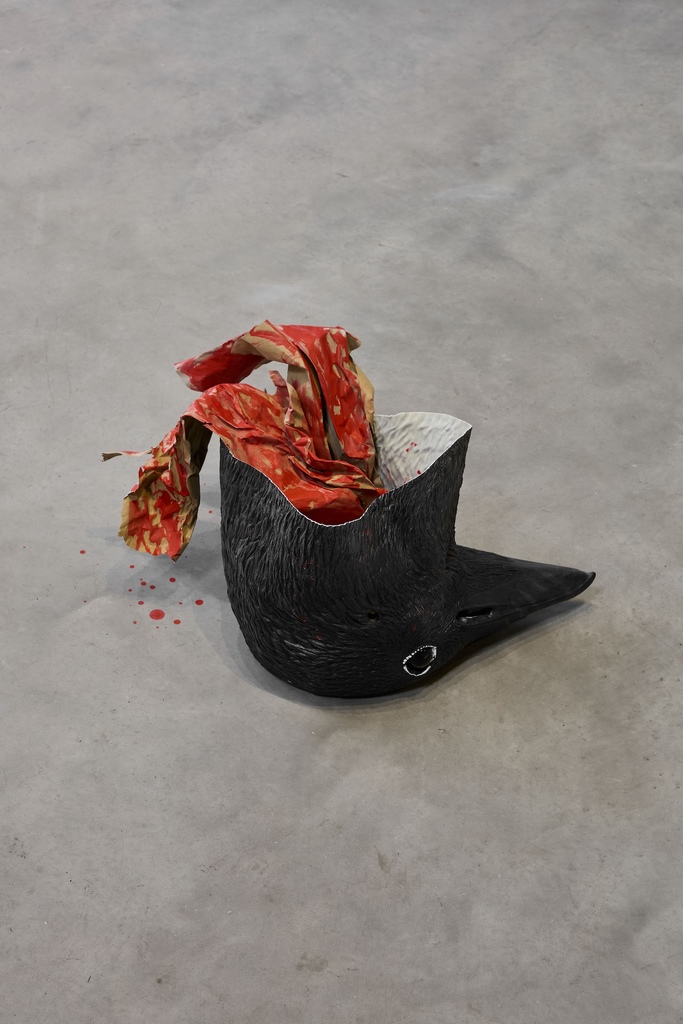
Caspar Heinemann, Sod All, 2025. Installation view at Studio Voltaire. Images courtesy
of the artist, Cabinet Gallery, and Studio Voltaire. Credit Sarah Rainer.
"making meaning from things that are non-functional, not-working, something close to broken"
Dead Ducks was partly inspired by Heinemann’s childhood memory of a science documentary in which the narrator states that comprehending the structure of reality from the standpoint of quantum physics is like explaining to a fish what lies outside of water. The artist is inviting us to enter into his work and situate ourselves within this state of ‘not-knowing’. As imitations, both the ducks and the crows’ heads are highly lifelike, used by hunters and gamekeepers because they attract or repel other animals. The more realistic these devices look, the more use that they are thought to have. Another kind of joke is developing in this show, one about art, repurposing, and how being realistic affects our imagination. If we reproduce art that looks exactly like reality, then it is used for the same cruel ends as reality. What Heinemann does is take these things and make them of no use.
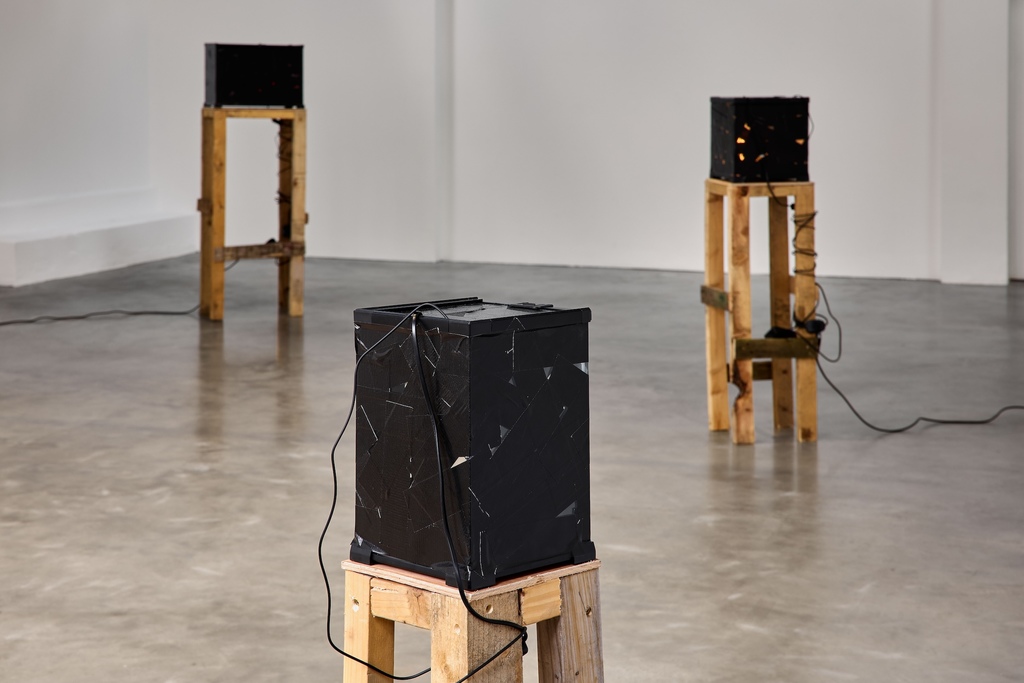
Caspar Heinemann, Sod All, 2025. Installation view at Studio Voltaire. Images courtesy
of the artist, Cabinet Gallery, and Studio Voltaire. Credit Sarah Rainer.
Presently suspicious of the idea that ‘making art’ elevates materials from the mundane, Heinemann finds that within the world of hobbies and leisure additional forms of value can be manipulated, played around with, and conjured, such that something devotional emerges from these acts. Whether it’s in woodwork, gardening, keeping pets, or whatever, the imagination is not only the possession of artists – and it would be arrogant to think that the art world is its sole locale. It is not only that Heinemann wants us to know this – his work encourages us to discover it in the world.
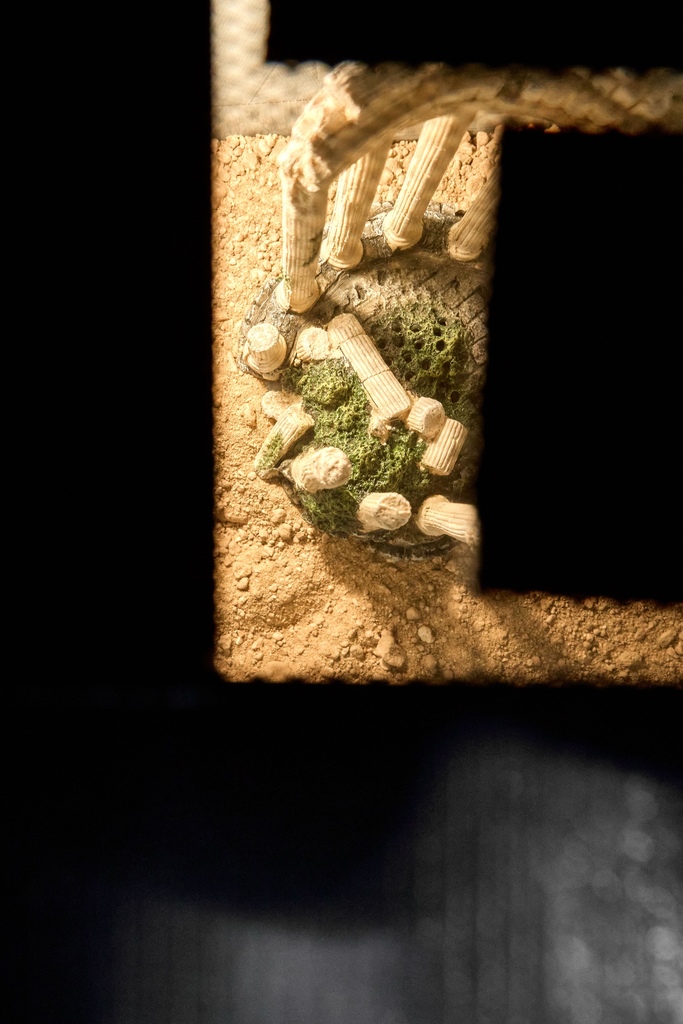
Caspar Heinemann, Sod All, 2025. Installation view at Studio Voltaire. Images courtesy
of the artist, Cabinet Gallery, and Studio Voltaire. Credit Sarah Rainer.
"Artists and their art can refuse the simplistic and brutal demands that things must simply make sense.
What might be the wider significance of subjecting ourselves to things that we cannot know – and what might we find there? Art can provide a unique space to dwell in what the poet John Keats called our: 'uncertainties, mysteries, doubts.' The domains in which the world is forced to make sense is often one administered by discipline and coercion. As Heinemann and I discuss whether the Scarer sequence is composed of three sculptures or two, he says that he wants such a question to be irresolvable: 'If we look at the recent news we see the risks of valorising clarity,' he says, in reference to the gender panics and legally enshrined transphobia in the UK and USA. Artists and their art can refuse the simplistic and brutal demands that things must simply make sense.
This is a brilliantly complex show. But a generous one that enlivens through its complexity. If there can be said to be one single raison d’etre for Sod All, then it might be that the viewer learns from encountering obstacles. Heinemann creates clashes of registers – unifying them in various found objects into temporary structures that are both ramshackle and repellant by design. But for all the show’s interest in closure, equally this work is full of openings, offerings, and strange spaces for the viewer to try and get inside (or is that outside).
By Ed Luker